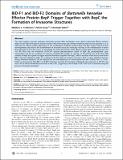BID-F1 and BID-F2 Domains of Bartonella henselae Effector Protein BepF Trigger Together with BepC the Formation of Invasome Structures
Author(s)
Truttmann, Matthias C.; Guye, Patrick; Dehio, Christoph
DownloadTruttmann-2011-BID-F1 and BID-F2 Do.pdf (768.6Kb)
PUBLISHER_CC
Publisher with Creative Commons License
Creative Commons Attribution
Terms of use
Metadata
Show full item recordAbstract
The gram-negative, zoonotic pathogen Bartonella henselae (Bhe) translocates seven distinct Bartonella effector proteins (Beps) via the VirB/VirD4 type IV secretion system (T4SS) into human cells, thereby interfering with host cell signaling [1], [2]. In particular, the effector protein BepG alone or the combination of effector proteins BepC and BepF trigger massive F-actin rearrangements that lead to the establishment of invasome structures eventually resulting in the internalization of entire Bhe aggregates [2], [3]. In this report, we investigate the molecular function of the effector protein BepF in the eukaryotic host cell. We show that the N-terminal [E/T]PLYAT tyrosine phosphorylation motifs of BepF get phosphorylated upon translocation but do not contribute to invasome-mediated Bhe uptake. In contrast, we found that two of the three BID domains of BepF are capable to trigger invasome formation together with BepC, while a mutation of the WxxxE motif of the BID-F1 domain inhibited its ability to contribute to the formation of invasome structures. Next, we show that BepF function during invasome formation can be replaced by the over-expression of constitutive-active Rho GTPases Rac1 or Cdc42. Finally we demonstrate that BID-F1 and BID-F2 domains promote the formation of filopodia-like extensions in NIH 3T3 and HeLa cells as well as membrane protrusions in HeLa cells, suggesting a role for BepF in Rac1 and Cdc42 activation during the process of invasome formation.
Date issued
2011-10Department
Massachusetts Institute of Technology. Department of Biological EngineeringJournal
PLoS ONE
Publisher
Public Library of Science
Citation
Truttmann, Matthias C., Patrick Guye, and Christoph Dehio. “BID-F1 and BID-F2 Domains of Bartonella Henselae Effector Protein BepF Trigger Together with BepC the Formation of Invasome Structures.” Ed. Dipshikha Chakravortty. PLoS ONE 6.10 (2011): e25106. Web. 15 Feb. 2012.
Version: Final published version
ISSN
1932-6203